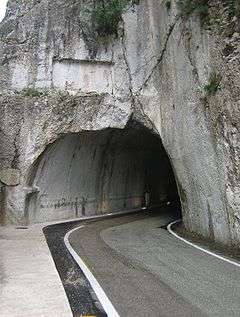Furlo Pass


The Furlo Pass (Italian: Gola del Furlo or Passo del Furlo) is a gorge on the ancient Roman road Via Flaminia in the Marche region of central Italy, where it passes near the Candigliano river, a tributary of the Metauro.
The gorge was formed between the Pietralata (889 m) and Paganuccio (976 m) mountains by the river Candigliano, which whooshed in full spate through the district until it was dammed in 1922. Since 2001 it has been included in a State Natural Reserve of the same name.
The Roman emperor Vespasian had a tunnel built here to facilitate passage on the Via Flaminia at the narrowest point of the gorge (hence the name, from the Latina forulum, meaning "small hole"). Next to it is a similar but smaller tunnel dating from Etruscan times. The tunnel has a length of 38.30 meters and a height of 5.95 meters. During the Gothic Wars (6th century), the Ostrogoth King Totila had the pass fortified, but his troops were ousted by the Roman general Belisarius. The Lombards conquered the pass between 570 and 578, and destroyed the fortifications.
In the 1930s, a profile of Benito Mussolini was sculpted on the slopes of Mount Pietralata, which was destroyed by partisans during World War II. In the 1980s, traffic in the Furlo tunnel was bypassed by the construction of two highway tunnels.
External links
Coordinates: 43°38′20″N 12°42′49″E / 43.638786°N 12.713713°E